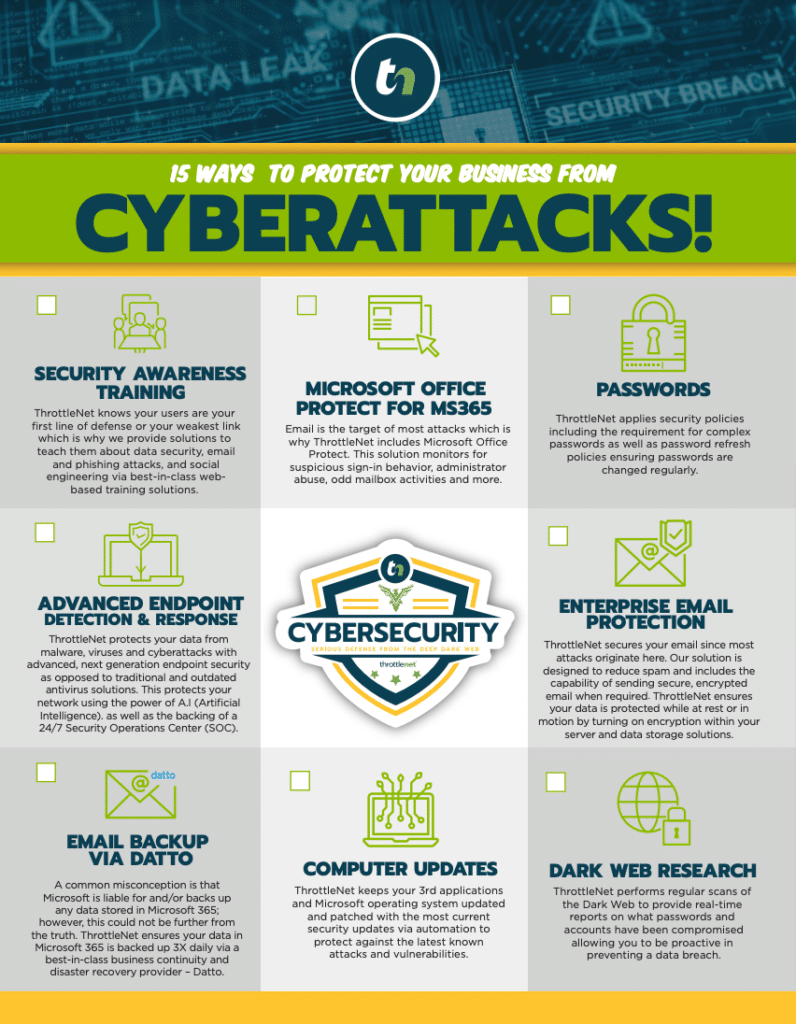Artificial intelligence (AI) has become both a powerful weapon and a double-edged sword in the world of cybersecurity. For small and medium-sized businesses (SMBs), AI in Cybersecurity offers advanced threat detection, automation, and enhanced security defenses—capabilities once only available to large enterprises. However, AI is also being leveraged by cybercriminals to create more sophisticated attacks, automate hacking attempts, and exploit vulnerabilities faster than ever before.
Due to this and given the amount of conflicting information, today we are outlining how AI in Cybersecurity is helping or hurting small to medium-sized businesses. As these organizations continue to digitize their operations and move towards cloud-based solutions, understanding how AI is shaping cybersecurity—both positively and negatively—has never been more critical.
Here’s a closer look at how AI is helping and, conversely, hurting small to medium-sized businesses along with some strategies to stay ahead in this evolving landscape.

How AI in Cybersecurity is Helping Small to Medium-Sized Businesses?
1. AI-Powered Threat Detection and Prevention
How it Helps: AI-driven security tools analyze massive amounts of data in real-time to detect suspicious patterns and anomalies that might indicate an attack.
- Identifies zero-day threats faster than traditional signature-based security tools.
- Reduces false positives by learning normal network behavior and flagging unusual activities.
- Detects advanced persistent threats (APTs) that evade traditional defenses. These include threat actors already on your network that are collecting data before implementing an attack.
2. AI-Driven Automated Cybersecurity Responses
How it Helps: AI-driven Security Orchestration, Automation, and Response (SOAR) platforms automate the response to threats, minimizing downtime and human intervention.
- Automatically isolates infected systems to prevent lateral movement, giving IT personnel time to respond without concern that the attack will propagate further.
- Blocks malicious IPs and quarantines phishing emails before users interact with them. This includes AI in Cybersecurity features like Impersonation Detection, which analyzes verbiage, links, and attachments in emails to identify potential attacks.
- Reduces incident response time, improving security efficiency for businesses with small or outsourced IT teams.
3. AI-Enhanced Endpoint Protection
How it Helps: AI-based Endpoint Detection and Response (EDR) and/or Managed Detection and Response (MDR) solutions continuously monitor and analyze endpoint behavior, offering real-time protection against malware, ransomware, and insider threats.
- AI detects fileless malware that traditional antivirus software might miss.
- Can roll back systems to pre-attack states, reducing the impact of ransomware, thus limiting it to a single user rather than the entire organization.
4. AI in Phishing and Fraud Prevention
How it Helps: AI-powered email security solutions analyze the language, structure, and intent of messages to detect phishing attempts.
- Prevents business email compromise (BEC) and impersonation attacks.
- Identifies deepfake voice and video scams, which are increasingly targeting SMBs.
5. Strengthening Compliance and Risk Management
How it Helps: AI in Cybersecurity helps SMBs comply with industry regulations like HIPAA and PCI DSS by:
- Automating security audits and vulnerability assessments.
- Monitoring access control violations and enforcing security policies.
- Providing compliance reporting and risk mitigation strategies.
How AI in Cybersecurity is Hurting SMB Cybersecurity
1. AI-Powered Cyberattacks Are More Sophisticated
How it Hurts: Cybercriminals are using AI to create more advanced and convincing attacks that are harder to detect.
- Deepfake Technology: Hackers use AI-generated deepfake videos or voice recordings to impersonate executives and trick employees into transferring funds or sharing sensitive information.
- Adaptive Malware: AI-driven malware can learn from security tools and modify itself to avoid detection.
2. AI Automates Cybercrime at Scale
How it Hurts: AI enables hackers to automate attacks, increasing the volume and frequency of cyber threats targeting small to medium-sized businesses.
- AI-Generated Phishing Emails: Cybercriminals use AI to craft personalized, grammatically correct phishing emails that bypass traditional spam filters.
- Credential Stuffing Attacks: AI speeds up brute-force login attempts, testing millions of password combinations per second.
3. Small to Medium-Sized Businesses May Struggle to Keep Up with AI-Driven Threats
How it Hurts: AI-powered attacks evolve faster than traditional security defenses, leaving SMBs vulnerable.
- Many SMBs lack the budget and expertise to deploy advanced AI-based cybersecurity solutions.
- Cybercriminals exploit outdated security tools that aren’t built to handle AI-powered attacks.
4. AI-Generated Misinformation and Social Engineering
How it Hurts: AI enables attackers to generate convincing fake news, forged documents, and synthetic identities to manipulate users and customers.
- AI chatbots and deepfake technology are being used for social engineering at an unprecedented scale.
- Employees and customers may fall for scams that look and sound completely legitimate.
How SMBs Can Stay Ahead of AI-Driven Cyber Threats
Adopt AI-Powered Security Solutions
- Use AI in Cybersecurity threat detection tools for real-time monitoring.
- Invest in AI-enhanced endpoint security (EDR/MDR) for stronger malware protection.
Implement Multi-Factor Authentication (MFA) and Zero Trust Security
- Require MFA for all logins and system access to prevent credential-based attacks.
- Apply Zero Trust principles, where every access request is verified, even inside the network.
Train Employees to Identify AI-Generated Threats
- Conduct regular security awareness training on AI-generated phishing, deepfake scams, and impersonation attacks.
- Simulate phishing attacks using AI-driven testing tools.
Leverage a Managed Security Provider (i.e., ThrottleNet)
- SMBs with limited IT resources should outsource cybersecurity to experts who deploy AI in Cybersecurity defenses.
- Ensure MSPs use advanced AI threat intelligence to detect emerging cyber risks.
Monitor AI-Driven Compliance Tools
- Use AI-assisted compliance monitoring to stay ahead of evolving regulations.
- Regularly review AI-based risk assessments and policy enforcement strategies.
Stay Updated on AI Cybersecurity Trends
- Follow cybersecurity reports and updates to understand how attackers are using AI.
- Participate in industry security groups that share threat intelligence.
AI is Both a Threat and a Solution for SMB Cybersecurity
AI in Cybersecurity has expanded so far past just using ChatGPT, it’s revolutionized how businesses approach threat detection, protection, and risk management. However, cybercriminals are also leveraging AI to create more complex, scalable, and automated attacks than ever before.
For small to medium-sized businesses, the key to survival in 2025 is adopting AI-powered cybersecurity solutions while staying educated and proactive against AI-driven threats. By leveraging AI-driven security tools, training employees, and partnering with expert-managed security providers, small businesses can stay ahead of the curve and protect themselves from the evolving cyber threat landscape. You can always learn more by keeping up-to-date on all our newsletters and blogs!

Chris Montgomery
ThrottleNet Sales Director
cmontgomery@throttlenet.com



